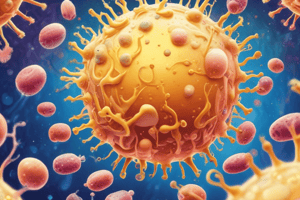Podcast
Questions and Answers
Which bacteria is responsible for Cutaneous anthrax?
Which bacteria is responsible for Cutaneous anthrax?
- Listeria monocytogenes
- Corynebacterium diphtheriae
- Staphylococcus epidermidis
- Bacillus anthracis (correct)
What toxin is produced by Corynebacterium diphtheriae?
What toxin is produced by Corynebacterium diphtheriae?
- Cytotoxin
- Epidermiolytic toxin
- Superantigen
- Diphtheris toxin (correct)
Which bacteria inhibits Opsonization through Protein A in its cell wall?
Which bacteria inhibits Opsonization through Protein A in its cell wall?
- Enterococcus spp.
- Staphylococcus aureus (correct)
- Bacillus anthracis
- Staphylococcus epidermidis
What is the characteristic feature of Enterococcus spp. in terms of hemolysis?
What is the characteristic feature of Enterococcus spp. in terms of hemolysis?
Which bacteria can be found as a pair and have a black appearance inside Bowel?
Which bacteria can be found as a pair and have a black appearance inside Bowel?
What percentage of Cutaneous anthrax cases are due to Bacillus anthracis?
What percentage of Cutaneous anthrax cases are due to Bacillus anthracis?
Which bacteria is known for causing food poisoning?
Which bacteria is known for causing food poisoning?
What is the mechanism of action for Coagulase produced by Staphylococcus aureus?
What is the mechanism of action for Coagulase produced by Staphylococcus aureus?
How does TSST Superantigen produced by Staphylococcus aureus affect T cells?
How does TSST Superantigen produced by Staphylococcus aureus affect T cells?
Which toxin is associated with causing the disease known as Toxic Shock Syndrome?
Which toxin is associated with causing the disease known as Toxic Shock Syndrome?
What is the primary function of Protein A found in the cell wall of Staphylococcus aureus?
What is the primary function of Protein A found in the cell wall of Staphylococcus aureus?
Which characteristic feature distinguishes Staphylococcus epidermidis from Staphylococcus aureus?
Which characteristic feature distinguishes Staphylococcus epidermidis from Staphylococcus aureus?
What distinguishes Enterococcus spp. in terms of their appearance under a microscope?
What distinguishes Enterococcus spp. in terms of their appearance under a microscope?
Which bacterium is responsible for causing Cutaneous anthrax?
Which bacterium is responsible for causing Cutaneous anthrax?
What is the mode of transmission for Bacillus anthracis to humans?
What is the mode of transmission for Bacillus anthracis to humans?
What is the pathogenic mechanism of action for Diphtheria toxin produced by Corynebacterium diphtheriae?
What is the pathogenic mechanism of action for Diphtheria toxin produced by Corynebacterium diphtheriae?
Flashcards are hidden until you start studying
Study Notes
Bacteria and Their Diseases
- Cutaneous anthrax is caused by Bacillus anthracis.
- Disease associated with Corynebacterium diphtheriae involves the production of Diphtheria toxin.
- Staphylococcus aureus inhibits opsonization through Protein A in its cell wall.
- Enterococcus spp. exhibits gamma hemolysis, indicating lack of hemolytic activity.
- Bacteroides fragilis can be found in pairs with a black appearance in the bowel.
Epidemiology and Prevalence
- Bacillus anthracis is responsible for over 95% of cutaneous anthrax cases.
- Staphylococcus aureus is notably responsible for food poisoning incidents.
Mechanisms of Toxins and Enzymes
- Coagulase, produced by Staphylococcus aureus, induces blood clotting, aiding bacterial survival.
- The Superantigen (TSST) from Staphylococcus aureus activates T cells, leading to systemic T cell activation and massive cytokine release.
- Toxic Shock Syndrome is mainly associated with TSST-1 toxin.
Unique Features and Identification
- Protein A in Staphylococcus aureus primarily binds to the Fc region of antibodies, impairing opsonization and phagocytosis.
- Staphylococcus epidermidis is distinguished from Staphylococcus aureus by its overall coagulase-negative status.
- Enterococcus spp. appear as cocci in pairs or chains, important for differentiation under the microscope.
Transmission and Infection Mechanisms
- Bacillus anthracis is transmitted to humans through contact with infected animals or contaminated products, with spores being a key factor.
- The pathogenicity of Diphtheria toxin involves inhibiting protein synthesis in host cells, leading to cell death.
Studying That Suits You
Use AI to generate personalized quizzes and flashcards to suit your learning preferences.




